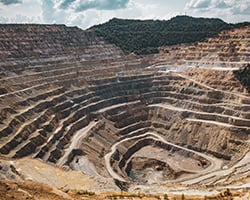With all the news surrounding rare earth elements (REE), it can be quite easy to get lost in conversations about the supply chain. The following key steps of the mine-to-magnet supply chain will guide you through any conversation.
Step #1: Mining (Ore)
 This process involves mining large amounts of ore that contain a mixture of rare earth minerals. Rare earth elements (REE) are found in large mixed mineral deposits such as bastnaesite, monazite, and xenotime. These mineral deposits contain large amounts of rare earth elements such as cerium, lanthanum, and neodymium. Rare earth minerals are in fact not that rare and deposits are located all over the planet.
This process involves mining large amounts of ore that contain a mixture of rare earth minerals. Rare earth elements (REE) are found in large mixed mineral deposits such as bastnaesite, monazite, and xenotime. These mineral deposits contain large amounts of rare earth elements such as cerium, lanthanum, and neodymium. Rare earth minerals are in fact not that rare and deposits are located all over the planet.
Step #2: Extraction (Mineral Concentrates)
The mined ore contains a mixture of rare earth elements and other minerals, so it is necessary to extract a concentrated mixture of rare earth elements. This is done using a multi-stage process of leaching and precipitation to harvest the REE’s. China is currently the largest producer of rare earth elements, but it is less commonly known that the United States was the world’s largest producer of rare earth elements until the 1990s.
Step #3: Separation (Oxides)
This step involves taking the mixed REE concentrates and separating them out into individual rare earth oxides through heated chemical known as calcination. Though the chemical processing required to produce rare earth oxides is pollutive and costly, China is enacting regulations to remediate waste and pursue sustainable processes.
Step #4: Processing (Metal)
Next, the oxides are processed into rare earth metals. These pure metals created in this step become the basic building blocks for producing rare earth magnets. China is currently the only commercially available source of rare earth metals on the market.
Step #5: Magnet production (Magnets)
 The final step in the process is to produce magnet material. This process requires 1) melting alloys using a combination of materials including rare earth metals, 2) milling, pressing and sintering to produce rare earth magnets with the desired properties, 3) machining the magnets into final part geometries, and 4) magnetizing finished magnets. Note: Rare earth magnets were first developed by the Air Force Research Laboratory and the world’s first commercially available rare earth magnets were produced by Electron Energy Corporation.
The final step in the process is to produce magnet material. This process requires 1) melting alloys using a combination of materials including rare earth metals, 2) milling, pressing and sintering to produce rare earth magnets with the desired properties, 3) machining the magnets into final part geometries, and 4) magnetizing finished magnets. Note: Rare earth magnets were first developed by the Air Force Research Laboratory and the world’s first commercially available rare earth magnets were produced by Electron Energy Corporation.
And there you have it…enough information on the rare earth magnet supply chain to get you through almost every conversation on the topic.

